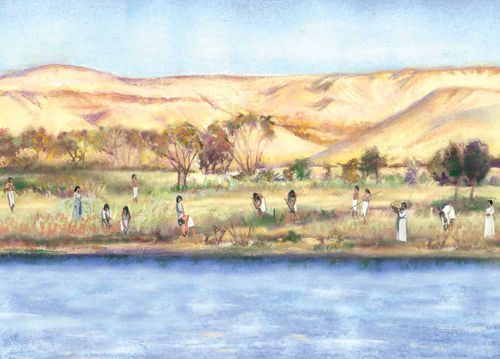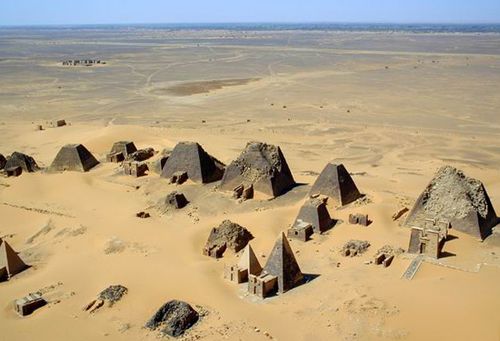

In ancient times, a number of different civilizations thrived in Africa. Two of these were the Egyptian civilization and the Kush civilization.

Ancient Egyptians traded their extra grain with the Kushites for gold and other goods.
Kush was the ancient Egyptian name for the African land of Nubia. It is located in eastern Africa, south of Egypt. Nubia was the home of an advanced civilization. Historians believe that the Kingdom of Kush began in about 2000 BCE. The Kushites were good farmers, metalworkers, and traders. Because of trade, they had contact with areas throughout eastern Africa.
Other than the Nile River, Egypt has few natural resources of its own. The Nile provided the water to help Egyptians grow food. For centuries, Egyptians traded the food they raised with the Kushites for other goods. The Kushites mined minerals and produced iron. They also traded with people from central Africa. Central Africans sold ebony wood, ivory, incense, and animal skins. Egyptians wore beautiful gold jewelry made by the Kushites. They decorated their homes with ivory and metalwork purchased in the marketplaces of Kush.
In 1500 BCE, the Egyptians were the strongest kingdom in the area as Kush foreign trade and influence declined. They began establishing an empire by conquering the land around them. Egyptian armies conquered lands along the Mediterranean coast to the north and east. They also conquered lands along the Nile, to the south. This included the area of Kush.
Over the next five centuries, 1500 BCE – 1000 BCE, the Kush people seemed to become Egyptian. They wore Egyptian-style clothing and worshipped Egyptian gods. Yet underneath their borrowed robes, the Kush people kept their culture and identity. They adapted pieces of Egyptian culture to their own culture.
In about 730 BCE Egypt grew weak. The Kushites struck at the Egyptians with all their might and defeated them. For a few decades, Kushite rulers became the pharaohs of Egypt. This was a great period in the history of Kush. But it lasted only 150 years. In 591 BCE, the Egyptians struck back, defeating Kush and capturing its capital.
The Kush people moved their capital farther south along the Nile to the city of Meroë (/muhr*oh*ee/). Meroë was surrounded by fine grazing land for herds of cattle, goats, and sheep. It was a major trading center. It was also one of Africa’s first iron-producing centers. Kush shipped its ironwork across Africa. Incredible rumors of Kush’s wealth spread far beyond Africa. The region was called the “Land of Gods.”

B N Chagny (CC BY-SA 1.0)
Unlike the pyramids of Egypt, some of Kush’s pyramids had flat tops.
The Greek historian Herodotus recorded some of the stories that had reached him about Meroë. Herodotus had heard about stone pyramids and a temple covered with sheets of gold shining like beacons in the bright African sun. Indeed, dozens of stone pyramids still stand outside Meroë. These pyramids are steeper than Egyptian pyramids and have flat tops. They were used as burial sites for the Kushite kings, just as the Egyptian pyramids were used as tombs for the pharaohs.

Sven-Steffen Arndt (CC BY-SA 2.0)
The gold bracelet was worn by a Kushite queen of Meroë.
Archaeologists have found jewelry and other valuable artifacts in these burial sites. These findings tell us that Meroë was once a wealthy place.

The three great kingdoms, Kush, Aksum, and Egypt, were all located in northeastern Africa.
Source: https://www.readworks.org/article/The-Kush-Kingdom/79bfe21a-3b66-4132-8207-204858cac4c7#!articleTab:content/
The Kingdom of Kush, located in present-day Sudan, was a powerful and influential civilization that thrived from around 1070 BCE to 350 CE. Initially a vassal state of Egypt, Kush gradually gained independence and flourished as a major trade center. The kingdom reached its peak during the 8th century BCE when its rulers, known as the Black Pharaohs, conquered Egypt and established the Twenty-Fifth Dynasty. This period marked a cultural renaissance, with the blending of Egyptian and Kushite traditions evident in art, architecture, and religion. However, the decline of Kush began with the Assyrian invasion in the 7th century BCE, followed by Egyptian and Roman invasions. Eventually, the kingdom was absorbed by the Kingdom of Axum. Despite its eventual downfall, the Kingdom of Kush left a lasting legacy, with its powerful rulers, unique art style, and significant influence on the ancient world.
2500 BCE
Early Settlements
The Kingdom of Kush traces its roots back to around 2500 BCE, when early settlements began to emerge in the region of Nubia, located in present-day Sudan. These settlements were primarily focused on agriculture and trade, as the fertile lands along the Nile River provided favorable conditions for farming.
Source: https://historytimelines.co/timeline/kingdom-of-kush
2000 BCE
Rise of the Kerma Culture
By around 2000 BCE, the Kerma Culture had emerged as a major power in the region. The city of Kerma became the capital of a powerful kingdom, which controlled vast territories and engaged in trade with neighboring civilizations, such as Egypt. The Kerma Culture developed its own distinctive architecture, art, and burial practices, setting it apart from its neighboring civilizations.
1500 BCE
Egyptian Influence
During this period, Egypt exerted significant influence over the Kingdom of Kush. The Egyptians established trade routes and maintained diplomatic relations with the Kushite rulers, which led to the adoption of Egyptian cultural practices, such as writing, religion, and architecture. The Kushite elites also began to intermarry with Egyptian nobility, further solidifying the ties between the two kingdoms.
1070 BCE
Kushite Rule of Egypt
In 1070 BCE, the Kingdom of Kush achieved a major milestone as its rulers, known as the Kushite Pharaohs, conquered Egypt. This marked a period of Kushite rule over Egypt, known as the Twenty-Fifth Dynasty. The Kushite Pharaohs successfully defended their kingdom against invasions from the Assyrians and maintained control over Egypt for nearly a century.
747 BCE
Assyrian Conquest and Decline
In 747 BCE, the Assyrians launched a campaign to conquer the Kingdom of Kush. Despite their initial successes, the Kushites were eventually defeated, and their capital city of Napata was sacked. This marked the beginning of a decline for the Kingdom of Kush, as it lost its dominance in the region and faced numerous challenges from neighboring powers.
300 BCE
Meroitic Kingdom
By around 300 BCE, the Kingdom of Kush shifted its capital to Meroe and entered a new phase known as the Meroitic Kingdom. During this period, the Kushites developed their own writing system, known as the Meroitic script, and continued to engage in trade with various civilizations, including the Roman Empire. The Meroitic Kingdom flourished for several centuries, with Meroe becoming a major center of commerce and culture
350 CE
Decline and Disappearance
The Kingdom of Kush began to decline in the 4th century CE, as it faced a series of invasions from the Kingdom of Aksum and other neighboring powers. The once-prosperous Meroitic Kingdom gradually lost its territories and influence, and by the 6th century CE, it had disappeared from historical records. The decline and disappearance of the Kingdom of Kush marked the end of an era for the Nubian civilization, although its cultural and historical legacy continues to be studied and celebrated today.

To see all four pages of this lesson, click HERE.
Via PBS, features clips on many African civilizations.
Via PBS, you can click on different areas of the African map and learn more about particular areas of historical significance.
Use this source for searching for a number of civilizations.
Via Blackpast.org, created by the University of Washington
Via Blackpast.org from the University of Washington
Via the BBC
Via Ancient Origins
Via Blackpast.org of the University of Washington
Via American Society of Biochemistry and Molecular Biology
Via the British Museum
Via National Geographic
Via The New York Times
Via South African History Online, towards a people's history
Via Blackpast.org of the University of Washington
Via Archaeology Magazine
Via Ancient Origins
Via the Metropolitan Museum of Art
Via the Atlanta Black Star
Via Ancient History Encyclopedia
Via NOVA from PBS
Via South African History Online, towards a people's history
Via the Metropolitan Museum of Art
Via Blackpast.org of the University of Washington
Via the BBC, features information on a number of West African Kingdoms
Via Scientific American
Via Blackpast.org of the University of Washington
Via the British Museum

Source: https://njsbf.org/wp-content/uploads/2021/03/Historian_Kits_Kush_Aksum_Mali_and_Great_Zimbabwe_Handout.pdf
